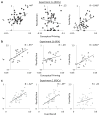Familiarity is related to conceptual implicit memory: an examination of individual differences
- PMID: 22833341
- PMCID: PMC3518453
- DOI: 10.3758/s13423-012-0298-7
Familiarity is related to conceptual implicit memory: an examination of individual differences
Abstract
Explicit memory is thought to be distinct from implicit memory. However, growing evidence has indicated that explicit familiarity-based recognition memory judgments rely on the same process that supports conceptual implicit memory. We tested this hypothesis by examining individual differences using a paradigm wherein we measured both familiarity and conceptual implicit memory within the same participants. In Experiments 1a and 1b, we examined recognition memory confidence ROCs and remember/know responses, respectively, to estimate recollection and familiarity, and used a free association task to measure conceptual implicit memory. The results demonstrated that, across participants, familiarity, but not recollection, was significantly correlated with conceptual priming. In contrast, in Experiment 2, utilizing a similar paradigm, a comparison of recognition memory ROCs and explicit associative cued-recall performance indicated that cued recall was related to both recollection and familiarity. These results are consistent with models assuming that familiarity-based recognition and conceptual implicit memory rely on similar underlying processes.
Figures


Similar articles
-
Activity reductions in perirhinal cortex predict conceptual priming and familiarity-based recognition.Neuropsychologia. 2014 Jan;52:19-26. doi: 10.1016/j.neuropsychologia.2013.10.006. Epub 2013 Oct 21. Neuropsychologia. 2014. PMID: 24157537 Free PMC article.
-
Developmental patterns in priming and familiarity in explicit recollection.J Exp Child Psychol. 2002 Jul;82(3):251-77. doi: 10.1016/s0022-0965(02)00007-3. J Exp Child Psychol. 2002. PMID: 12093109
-
Conceptual priming and familiarity: different expressions of memory during recognition testing with distinct neurophysiological correlates.J Cogn Neurosci. 2010 Nov;22(11):2638-51. doi: 10.1162/jocn.2009.21341. J Cogn Neurosci. 2010. PMID: 19702474 Clinical Trial.
-
On the relationship between recognition familiarity and perceptual fluency: evidence for distinct mnemonic processes.Acta Psychol (Amst). 1998 Apr;98(2-3):211-30. doi: 10.1016/s0001-6918(97)00043-7. Acta Psychol (Amst). 1998. PMID: 9621831 Review.
-
Measuring recollection and familiarity in the medial temporal lobe.Hippocampus. 2010 Nov;20(11):1195-205. doi: 10.1002/hipo.20854. Hippocampus. 2010. PMID: 20848603 Free PMC article. Review.
Cited by
-
Hypergraph-based recognition memory model for lifelong experience.Comput Intell Neurosci. 2014;2014:354703. doi: 10.1155/2014/354703. Epub 2014 Oct 13. Comput Intell Neurosci. 2014. PMID: 25371665 Free PMC article.
-
Electrophysiological correlates associated with contributions of perceptual and conceptual fluency to familiarity.Front Hum Neurosci. 2015 Jun 5;9:321. doi: 10.3389/fnhum.2015.00321. eCollection 2015. Front Hum Neurosci. 2015. PMID: 26097450 Free PMC article.
-
Activity reductions in perirhinal cortex predict conceptual priming and familiarity-based recognition.Neuropsychologia. 2014 Jan;52:19-26. doi: 10.1016/j.neuropsychologia.2013.10.006. Epub 2013 Oct 21. Neuropsychologia. 2014. PMID: 24157537 Free PMC article.
-
A meta-analysis of event-related potential correlates of recognition memory.Psychon Bull Rev. 2023 Dec;30(6):2083-2105. doi: 10.3758/s13423-023-02309-y. Epub 2023 Jul 11. Psychon Bull Rev. 2023. PMID: 37434046 Free PMC article. Review.
-
Ayahuasca enhances the formation of hippocampal-dependent episodic memory without impacting false memory susceptibility in experienced ayahuasca users: An observational study.J Psychopharmacol. 2025 Apr;39(4):339-349. doi: 10.1177/02698811241301216. Epub 2024 Nov 29. J Psychopharmacol. 2025. PMID: 39614620 Free PMC article.
References
-
- Blaxton TA. Dissociations among memory measures in memory impaired subjects: Evidence for a processing account of memory. Memory & Cognition. 1992;20:549–562. - PubMed
-
- Challis BH, Sidhu R. Dissociative effect of massed repetition on implicit and explicit measures of memory. Journal of Experimental Psychology: Learning, Memory, and Cognition. 1993;19:115–127. - PubMed
-
- Donaldson DI, Petersen SE, Buckner RL. Dissociating memory retrieval processes using fMRI: Evidence that priming does not support recognition memory. Neuron. 2001;31:1047–1059. - PubMed
Publication types
MeSH terms
Grants and funding
LinkOut - more resources
Full Text Sources
Medical

